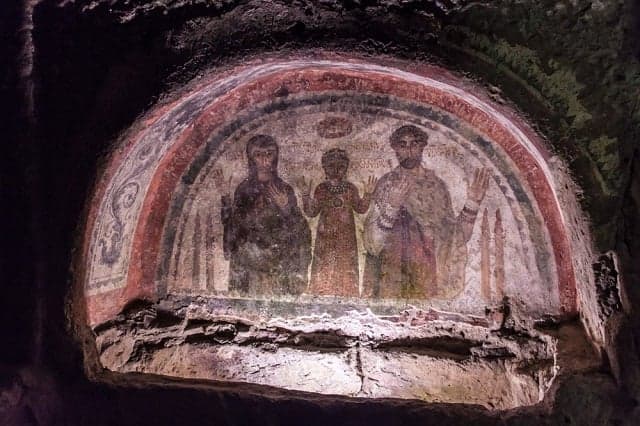Italian ham company to fund restoration of Naples catacombs fresco

An Italian ham company will fund the restoration of an ancient underground fresco in Naples.
The fresco is located in the city's San Gennaro catacombs, a huge network of underground tombs dating back to the second century BC and containing the tomb of San Gennaro, one of Naples's patron saints. The complex is one of the southern city's most popular attractions, ranked sixth in all of Italy on travel review site TripAdvisor.
Italy’s biggest prosciutto producer, Parmacotto, has provided €30,000 for the project, which will begin in January and is expected to take two years.
That money will go towards the preservation of the centuries-old fresco, which has been damaged by the damp climate of the catacombs over the years.
Speaking at the project's announcement on Wednesday, Parmacotto CEO Andrea Schivazappa said: "We chose [to support] the catacombs for the cultural value, but also for the powerful social significance, because it shows how a group of young people from a tough neighborhood can better express their potential if given the opportunity."
The catacombs are managed by Paranza, a cooperative made up of young people in the Sanità neighbourhood, an area which has become known for high levels of poverty and unemployment.
READ ALSO: 'How I fell in love with Naples, a city full of contrasts'
Schivazappa likened the huge increase in visitors to the catacombs over recent years, under Paranza's management, to the history of his own company, which has relaunched in the last three years.
And there's another link between the catacombs and prosciutto. The history of Italian cured ham dates back to pre-Roman times, when Roman soldiers began to preserve meat in order to take with them on their journeys across the empire.
According to Italian food company Barilla, Roman writer Cato penned a technical explanation for making prosciutto in the second century, and producers today follow more or less the same process.
Recent years have seen a string of famous Italian sites renovated with funds from private donors, often from Italy's two most globally renowned sectors, luxury fashion and food.
In April this year, the founder of Italian food chain Eataly announced that he would fund a €1 million hi-tech restoration of Leonardo Da Vinci's masterpiece, The Last Supper, to preserve the delicate painting.
That came days after an insurance company announced it would finance a restoration of Venice's Royal Gardens, and fashion house Gucci said it would fund a revamp of the Boboli Gardens in Florence.
Other sites to have received makeovers from private donors include Rome's Colosseum, Trevi Fountain, and Spanish Steps.
READ ALSO: Italian accidentally drills through 500-year-old Naples church fresco
Comments
See Also
The fresco is located in the city's San Gennaro catacombs, a huge network of underground tombs dating back to the second century BC and containing the tomb of San Gennaro, one of Naples's patron saints. The complex is one of the southern city's most popular attractions, ranked sixth in all of Italy on travel review site TripAdvisor.
Italy’s biggest prosciutto producer, Parmacotto, has provided €30,000 for the project, which will begin in January and is expected to take two years.
That money will go towards the preservation of the centuries-old fresco, which has been damaged by the damp climate of the catacombs over the years.
Speaking at the project's announcement on Wednesday, Parmacotto CEO Andrea Schivazappa said: "We chose [to support] the catacombs for the cultural value, but also for the powerful social significance, because it shows how a group of young people from a tough neighborhood can better express their potential if given the opportunity."
The catacombs are managed by Paranza, a cooperative made up of young people in the Sanità neighbourhood, an area which has become known for high levels of poverty and unemployment.
READ ALSO: 'How I fell in love with Naples, a city full of contrasts'
Schivazappa likened the huge increase in visitors to the catacombs over recent years, under Paranza's management, to the history of his own company, which has relaunched in the last three years.
And there's another link between the catacombs and prosciutto. The history of Italian cured ham dates back to pre-Roman times, when Roman soldiers began to preserve meat in order to take with them on their journeys across the empire.
According to Italian food company Barilla, Roman writer Cato penned a technical explanation for making prosciutto in the second century, and producers today follow more or less the same process.
That came days after an insurance company announced it would finance a restoration of Venice's Royal Gardens, and fashion house Gucci said it would fund a revamp of the Boboli Gardens in Florence.
Other sites to have received makeovers from private donors include Rome's Colosseum, Trevi Fountain, and Spanish Steps.
READ ALSO: Italian accidentally drills through 500-year-old Naples church fresco
Join the conversation in our comments section below. Share your own views and experience and if you have a question or suggestion for our journalists then email us at [email protected].
Please keep comments civil, constructive and on topic – and make sure to read our terms of use before getting involved.
Please log in here to leave a comment.